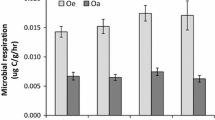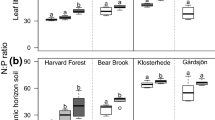ABSTRACT
This article reports responses of two different forest ecosystems to 9 years (1988–96) of chronic nitrogen (N) additions at the Harvard Forest, Petersham, Massachusetts. Ammonium nitrate (NH4NO3) was applied to a pine plantation and a native deciduous broad-leaved (hardwood) forest in six equal monthly doses (May–September) at four rates: control (no fertilizer addition), low N (5 g N m-2 y-1), high N (15 g N m-2 y-1), and low N + sulfur (5 g N m-2 y-1 plus 7.4 g S m-2 y-1). Measurements were made of net N mineralization, net nitrification, N retention, wood production, foliar N content and litter production, soil C and N content, and concentrations of dissolved organic carbon (DOC) and nitrogen (DON) in soil water. In the pine stand, nitrate losses were measured after the first year of additions (1989) in the high N plot and increased again in 1995 and 1996. The hardwood stand showed no significant increases in nitrate leaching until 1995 (high N only), with further increases in 1996. Overall N retention efficiency (percentage of added N retained) over the 9-year period was 97–100% in the control and low N plots of both stands, 96% in the hardwood high N plot, and 85% in the pine high N plot. Storage in aboveground biomass, fine roots, and soil extractable pools accounted for only 16–32% of the added N retained in the amended plots, suggesting that the one major unmeasured pool, soil organic matter, contains the remaining 68–84%. Short-term redistribution of 15N tracer at natural abundance levels showed similar division between plant and soil pools. Direct measurements of changes in total soil C and N pools were inconclusive due to high variation in both stands. Woody biomass production increased in the hardwood high N plot but was significantly reduced in the pine high N plot, relative to controls. A drought-induced increase in foliar litterfall in the pine stand in 1995 is one possible factor leading to a measured increase in N mineralization, nitrification, and nitrate loss in the pine high N plot in 1996.
Similar content being viewed by others
Author information
Authors and Affiliations
Additional information
Received 2 April 1999; Accepted 29 October 1999.
Rights and permissions
About this article
Cite this article
Magill, A., Aber, J., Berntson, G. et al. Long-Term Nitrogen Additions and Nitrogen Saturation in Two Temperate Forests. Ecosystems 3, 238–253 (2000). https://doi.org/10.1007/s100210000023
Issue Date:
DOI: https://doi.org/10.1007/s100210000023




